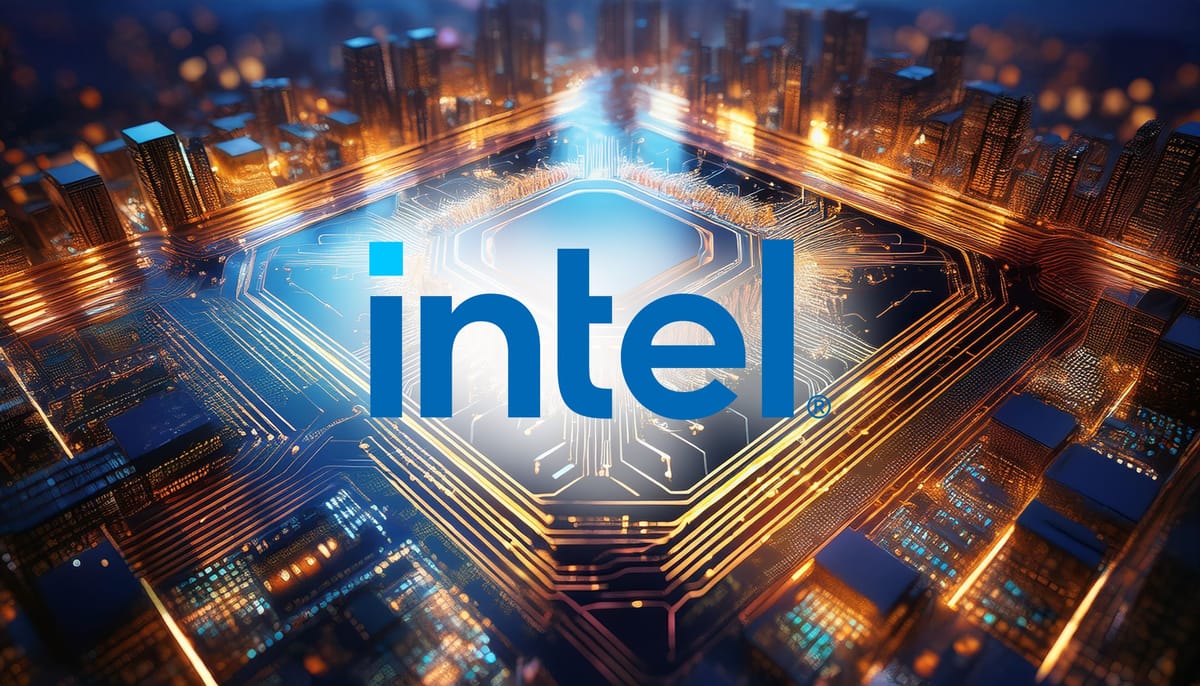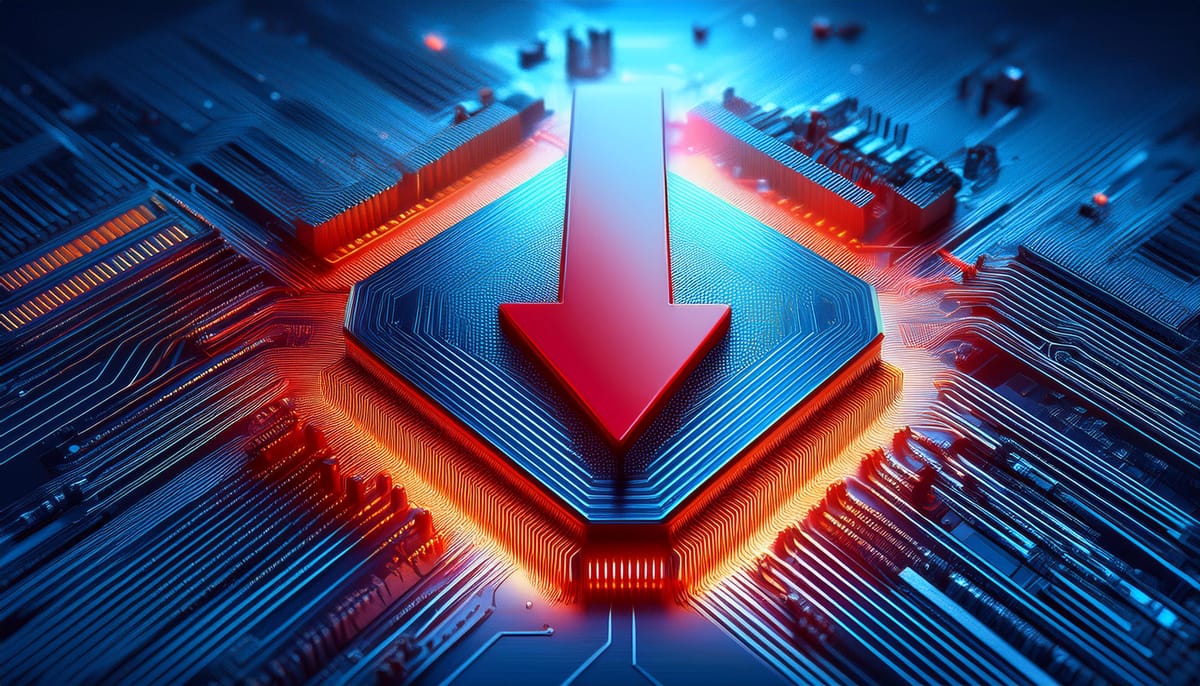In the ever-evolving landscape of the semiconductor industry, a seismic shift is underway. The U.S. government's recent move to bolster domestic chip production through the CHIPS Act has thrust Intel, the country's largest chip manufacturer, into the spotlight. With up to $8.5 billion in direct funding on the horizon, we're witnessing a potential renaissance for Intel and, by extension, the entire U.S. semiconductor ecosystem.
The semiconductor industry's importance extends far beyond just making chips. It's a cornerstone of technological advancement, powering everything from smartphones to supercomputers, and playing a crucial role in emerging fields like artificial intelligence and 5G networks. Intel's position at the forefront of this industry makes the potential government funding a matter of significant interest and importance.
The CHIPS Act: A Game-Changer for Intel
The CHIPS Act represents a watershed moment for the U.S. semiconductor industry, and Intel stands to be a primary beneficiary. The potential $8.5 billion in direct funding is just the tip of the iceberg. When we factor in the additional benefits, including up to $11 billion in federal loans and a 25% Investment Tax Credit (ITC) on qualified investments exceeding $100 billion, we're looking at a comprehensive package that could fundamentally alter Intel's trajectory.
Pat Gelsinger, Intel's CEO, encapsulated the significance of this moment in a recent statement:
"This is a meaningful step toward incentivizing the manufacturing of the most advanced semiconductors in the United States. It provides Intel with the tools we need to significantly accelerate our expansion plans in Arizona, Ohio, New Mexico, and Oregon."
This quote, presented in a ghost CMS-friendly format, underscores the transformative potential of the CHIPS Act funding for Intel. However, it's crucial to approach this development with a balanced perspective, considering both the opportunities and challenges it presents.

Opportunities:
- Expanded Manufacturing Capacity: The funding will support Intel's ambitious plans to invest more than $100 billion in the U.S. over five years. This massive infusion of capital could help Intel close the gap with competitors like TSMC and Samsung in advanced chip manufacturing.
- Technological Advancements: With dedicated funding for semiconductor research and development in Oregon, Intel has the potential to accelerate innovation in chip design and manufacturing processes.
- Strengthened Market Position: By bolstering its domestic manufacturing capabilities, Intel could become a more attractive partner for both government and commercial clients seeking secure, U.S.-based chip production.
Challenges:
- Execution Risk: Intel's recent track record in delivering on ambitious manufacturing goals has been mixed. The company will need to demonstrate that it can effectively utilize this funding to achieve tangible results.
- Competition Remains Fierce: While the CHIPS Act funding provides a significant boost, Intel's competitors aren't standing still. TSMC and Samsung continue to invest heavily in advanced manufacturing processes.
- Long-Term Sustainability: The funding provides a short-term boost, but Intel will need to ensure that its expanded operations remain competitive and profitable in the long run without ongoing government support.

Intel's Strategic Vision: Betting Big on U.S. Manufacturing
Intel's strategy under the CHIPS Act funding is clear: double down on U.S.-based manufacturing and position itself as the cornerstone of America's semiconductor renaissance. This approach aligns with broader national security and economic objectives, potentially giving Intel a strategic advantage in securing government contracts and partnerships.
Ann Kelleher, Intel executive vice president and general manager of Technology Development, emphasized this point in a recent statement:
"Our investment plans are a testament to Intel's commitment to advancing U.S. leadership in semiconductor manufacturing. We're not just building factories; we're laying the foundation for America's technological future."
This strategy, however, is not without its risks. Let's break down the key components:
Product Roadmap and Technological Advancements
Intel's product roadmap is ambitious, with a focus on regaining process leadership through its Intel 18A chip production process. This technology, featuring the advanced RibbonFET transistor architecture, represents a significant leap forward. The upcoming Clearwater Forest server processor, expected to boast up to 300 billion transistors, showcases Intel's commitment to pushing the boundaries of chip design.
However, it's important to note that Intel's competitors aren't standing still. TSMC and Samsung have their own advanced processes in development, and the race for transistor density and performance continues unabated.
Financial Performance and Market Positioning
Intel's financial performance has been a point of concern in recent years. The company's stock has declined significantly, and its market share in key segments like data center processors has eroded in the face of competition from AMD and others.
The CHIPS Act funding provides a much-needed boost, but it doesn't automatically solve Intel's underlying challenges. The company will need to translate this investment into improved products and market share gains to truly turn the corner.
A critical analysis of Intel's financial statements reveals a company in transition:
- Revenue has been inconsistent, with declines in key segments like the Client Computing Group.
- Gross margins have compressed, reflecting increased competition and the costs associated with catching up in manufacturing technology.
- R&D expenses remain high, underscoring the company's commitment to innovation but also pressuring profitability.
Looking ahead, Intel's ability to improve its financial performance will hinge on successfully executing its manufacturing expansion plans and bringing competitive products to market in a timely manner.
The Broader Industry Context: Intel's Role in the U.S. Semiconductor Ecosystem
To fully appreciate Intel's position, we need to consider the broader industry context. The global semiconductor industry is in the midst of a significant realignment, driven by geopolitical tensions, supply chain vulnerabilities, and the increasing strategic importance of chip manufacturing.
Intel's CEO, Pat Gelsinger, framed the company's role in this shifting landscape:
"Intel is uniquely positioned to help build a more resilient and sustainable semiconductor supply chain for the U.S. and Europe. Our technology spans everything from the edge to the cloud, and we're committed to being a reliable partner for both government and commercial clients."
This statement underscores Intel's ambition to be more than just a chip manufacturer; the company aims to be a linchpin in the U.S. technology ecosystem. However, this ambition comes with significant responsibilities and challenges:
Opportunities:
- National Security Implications: Intel's "Secure Enclave" program, supported by up to $3 billion in additional funding, positions the company as a critical partner for the U.S. Department of Defense. This could lead to long-term, stable contracts and a competitive moat in sensitive applications.
- AI and Emerging Technologies: As artificial intelligence continues to drive demand for advanced chips, Intel's investments in cutting-edge manufacturing could pay dividends. The company's ability to produce high-performance, energy-efficient chips for AI applications will be crucial for its future success.
- Ecosystem Development: Intel's expansions in Arizona, New Mexico, Ohio, and Oregon have the potential to create semiconductor hubs, attracting suppliers, research institutions, and other related businesses. This could strengthen Intel's competitive position and create a virtuous cycle of innovation and growth.
Challenges:
- Global Competition: While the U.S. is investing heavily in domestic semiconductor production, other countries are doing the same. China, South Korea, and the European Union are all pouring billions into their semiconductor industries, potentially eroding any advantage gained through the CHIPS Act.
- Talent Acquisition and Retention: The semiconductor industry faces a significant talent shortage. Intel will need to compete aggressively to attract and retain the skilled workers needed to staff its expanded operations.
- Technological Disruption: The industry is prone to disruptive innovations. Intel will need to remain agile and open to new approaches, even as it invests heavily in current technologies.
A Critical Evaluation of Intel's Prospects
As we assess Intel's future prospects in light of the potential government funding, it's essential to maintain a balanced and critical perspective. While the CHIPS Act funding undoubtedly provides a significant boost, it's not a panacea for all of Intel's challenges.
On the positive side, the funding addresses one of Intel's key weaknesses in recent years: the need for massive capital investment to catch up in manufacturing technology. With up to $8.5 billion in direct funding and additional loans and tax credits, Intel has the financial firepower to accelerate its plans and potentially leapfrog competitors in certain areas.
Moreover, the strategic importance of having a leading-edge semiconductor manufacturer on U.S. soil cannot be overstated. This geopolitical advantage could translate into long-term partnerships and contracts that provide stability and growth opportunities for Intel.
However, several critical questions remain:
- Can Intel execute effectively? The company's track record in recent years has been mixed, with delays in new manufacturing processes and loss of market share in key segments. The additional funding doesn't automatically solve execution challenges.
- Will the investment translate into market share gains? While improved manufacturing capabilities are crucial, Intel also needs to design competitive products that meet market needs. The company faces stiff competition from AMD in the x86 market and from Arm-based designs in mobile and increasingly in the data center.
- How will Intel balance its role as both a manufacturer and a chip designer? As Intel expands its foundry services, it may face conflicts of interest and challenges in allocating resources between its own chip designs and those of potential foundry customers.
- Is the level of government support sustainable in the long term? While the current geopolitical climate supports investment in domestic semiconductor manufacturing, future administrations may have different priorities.
Intel's Technological Roadmap: A Closer Look
Intel's technological roadmap is ambitious and central to its strategy for regaining leadership in the semiconductor industry. Let's examine some key elements:
Intel 18A Process
The Intel 18A process, slated for introduction in 2025, represents a significant leap forward in transistor technology. Pat Gelsinger has stated:
"With Intel 18A, we're not just catching up to the competition; we're positioning ourselves to retake process leadership. This isn't just an incremental improvement; it's a step-change in semiconductor manufacturing."
The key innovations in Intel 18A include:
- RibbonFET Architecture: This new transistor design promises improved performance and energy efficiency compared to current FinFET designs.
- PowerVia Technology: By moving power delivery to the back of the chip, Intel aims to improve performance and reduce signal noise.
- High NA EUV Lithography: This advanced lithography technology will enable Intel to produce smaller, more densely packed transistors.
While these advancements sound promising, it's important to note that Intel's competitors are also innovating rapidly. TSMC and Samsung have their own advanced processes in development, and the race for transistor density and performance is far from over.
Clearwater Forest Server Processor
Intel's upcoming Clearwater Forest server processor, with its reported 300 billion transistors, is a clear statement of intent in the high-performance computing and AI markets. This processor aims to compete directly with Nvidia's AI-focused GPUs and AMD's server CPUs.
However, the success of Clearwater Forest will depend not just on raw transistor count, but on factors such as:
- Energy efficiency
- Software ecosystem and developer support
- Integration with emerging AI workflows
Intel will need to excel in all these areas to make Clearwater Forest a true game-changer in the market.
Financial Implications and Market Dynamics
The CHIPS Act funding comes at a critical time for Intel's finances. Let's look at some key financial metrics and their implications:
- Revenue Growth: Intel's revenue has been inconsistent in recent years, with declines in key segments like the Client Computing Group. The company will need to leverage its manufacturing investments to drive growth in emerging areas like AI and edge computing.
- Gross Margins: Intel's historically high gross margins have come under pressure due to increased competition and manufacturing challenges. The success of the Intel 18A process and other advanced technologies will be crucial for maintaining healthy margins in the future.
- Capital Expenditure: The massive investments planned under the CHIPS Act funding will significantly increase Intel's capital expenditure. While this is necessary for long-term competitiveness, it may pressure short-term profitability and free cash flow.
- R&D Spending: Intel has maintained high levels of R&D spending, which is critical for innovation. The challenge will be ensuring that this spending translates into marketable products and technologies that can drive revenue growth.
Market dynamics also play a crucial role in Intel's future prospects. The company faces intense competition in several key areas:
- Data Center: AMD has made significant inroads with its EPYC processors, while Arm-based designs from companies like Amazon and Ampere are gaining traction.
- Client Computing: Apple's transition to its own silicon and the rise of Arm-based laptops present challenges to Intel's traditional stronghold.
- AI and High-Performance Computing: Nvidia dominates the AI accelerator market, while AMD competes strongly in both CPUs and GPUs for high-performance computing.
Intel's success will depend on its ability to deliver compelling products in these competitive markets while also opening new revenue streams through its foundry services.
Conclusion: A Pivotal Moment for Intel
As we look at Intel's potential government funding and its implications, it's clear that we're witnessing a pivotal moment not just for the company, but for the entire U.S. semiconductor industry. The CHIPS Act funding provides Intel with a unique opportunity to reinvent itself and reassert its leadership in advanced chip manufacturing.
However, the path forward is far from straightforward. Intel faces significant execution challenges, intense competition, and the need to balance short-term financial performance with long-term strategic investments. The company's success will depend on its ability to translate its ambitious plans into tangible results: cutting-edge products, efficient manufacturing, and ultimately, market share gains.
From my perspective, Intel's prospects are cautiously optimistic. The combination of government support, a renewed focus on manufacturing excellence, and the company's deep expertise in semiconductor technology create a solid foundation for future success. However, the semiconductor industry is notoriously dynamic and competitive. Intel will need to execute flawlessly and remain agile in the face of technological and market shifts.
For those following the semiconductor industry, Intel's journey in the coming years will be fascinating to watch. It's a story that goes beyond just one company; it's about the future of technology, national competitiveness, and the global balance of power in one of the world's most critical industries.
As we monitor Intel's progress, key indicators to watch will include:
- Timely delivery of the Intel 18A process and associated products
- Market reception of new offerings like the Clearwater Forest server processor
- Growth and profitability of Intel's foundry services business
- The company's ability to win strategic contracts, particularly in areas related to national security
- Intel's success in attracting and retaining top talent in a competitive industry
In closing, while the potential government funding provides Intel with a significant boost, the true test lies in how effectively the company can leverage this opportunity to drive innovation, improve its competitive position, and create long-term value. The stakes are high, not just for Intel, but for the entire U.S. technology ecosystem. The coming years will reveal whether this investment marks the beginning of a new era of American semiconductor leadership or a costly lesson in the challenges of reviving a complex, globally competitive industry.






